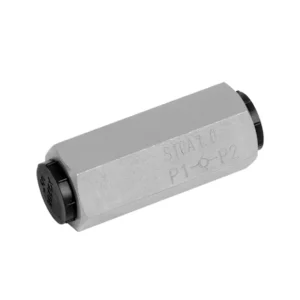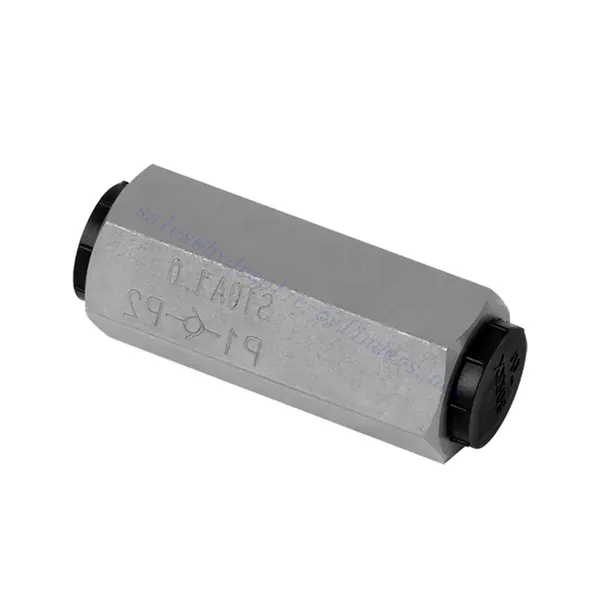S Series Check Hydraulic Valve
Jako jeden z výrobců, dodavatelů a vývozců hydraulických válců nabízíme hydraulické válce a mnoho dalších výrobků.
Kontaktujte nás, prosím, pro podrobnosti.
Mail:sales@hydraulic-cylinders.net
Výrobce, dodavatel a vývozce hydraulických válců.
S Series Check Hydraulic Valve

The S series check hydraulic valve is a cutting-edge solution designed to enhance the performance and reliability of hydraulic systems. With its exceptional design and advanced features, this valve is poised to optimize fluid control and ensure efficient operation.
The S series check hydraulic valve is an indispensable component for hydraulic systems, offering reliability, efficiency, and versatility. Its reliable check functionality, high flow capacity, and space-saving design optimize fluid control and enhance system performance. Following the recommended usage methods and adhering to regular maintenance practices, the s series check hydraulic valve will continue providing reliable and efficient operation. Upgrade your hydraulic system with the S series check hydraulic valve and experience the benefits of improved flow control and system reliability.
S Series Check Hydraulic Valve Key Characteristics:
- Reliable Check Functionality:
- The S series check hydraulic valve incorporates an aspring-loaded check mechanism for reliable fluid flow control.
- This feature ensures that the valve allows fluid to flow in one direction while preventing backflow in the opposite direction, maintaining system integrity and preventing potential damage.
- High Flow Capacity:
- The valve is designed to handle high flow rates, making it suitable for efficient and unrestricted fluid flow applications.
- Its optimized flow path minimizes pressure drop, enhancing system performance and reducing energy consumption.
- Compact and Space-Saving Design:
- The S series check hydraulic valve features a compact design, making it ideal for installations with limited space.
- Its streamlined design allows easy integration into hydraulic systems without compromising overall efficiency.
- Versatile Application:
- This hydraulic valve is suitable for various applications, including industrial machinery, agricultural equipment, construction machinery, and more.
- Its versatility makes it a reliable choice for various hydraulic system configurations.
S Series Check Hydraulic Valve Parameter:
| Size | 6 | 8 | 10 | 15 | 20 | 25 | 30 | 40 | |
| Max. flow-rate | L/min | 15 | 30 | 40 | 120 | 200 | 300 | 400 | 600 |
| Max. operating pressure | bar | 315 210(NPTF1 1/4 NPTF1 1/2) | |||||||
| Crack pressure | bar | 0.5; 1.5; 3; 5 | |||||||
| Fluid | Mineral oil; Phosphate ester | ||||||||
| Fluid temperature range | ℃ | -30 to +80 | |||||||
| Viscosity range | mm2/s | 2.8 to 500 | |||||||
| Degree of contamination | Maximum permissible degree of fluid contamination: Class 9. NAS 1638 or 20/18/15, ISO4406 | ||||||||
S Series Check Hydraulic Valve Advantages:
• Conical seat valve
• Sub-plate mounting
• Multiple levels of opening pressure
Usage Method Of S Series Check Hydraulic Valve:
- System Integration:
- Identify the appropriate location for the S series check hydraulic valve within the hydraulic system.
- Ensure compatibility with the system’s pressure and flow requirements.
- Install the valve in line with the fluid flow, considering the desired direction of flow and the need for check functionality.
- Proper Orientation:
- Pay attention to the directional arrows on the valve body indicating the preferred flow direction.
- Ensure that the valve is installed with the correct orientation to guarantee proper check functionality.
- Connection:
- Select compatible hydraulic fittings and hoses for secure and leak-free connections.
- Follow the manufacturer’s instructions for proper torque values during the installation process.
- Use appropriate thread sealants or tape to ensure a reliable seal.
- Testing and Operation:
- After installation, test the valve’s functionality by operating the hydraulic system.
- Observe the flow direction and check that the valve allows fluid to pass in the intended order while preventing backflow.
- Monitor the system for any abnormalities, such as leaks or pressure fluctuations, and address any issues promptly.
How To Replace Seals On A Hydraulic Cylinder?
Replacing seals on a hydraulic cylinder is an essential maintenance task to ensure the proper functioning of the cylinder. Here is a step-by-step guide on how to replace seals on a hydraulic cylinder:
- Safety Precautions:
- Prioritize safety by wearing appropriate personal protective equipment, including gloves and safety glasses.
- Make sure the hydraulic system is depressurized. Turn off the power source and relieve any residual pressure by operating the control valve several times.
- Cylinder Removal:
- Detach the hydraulic cylinder from the equipment or machinery. Depending on the specific setup, this may involve removing mounting bolts or pins.
- Support the cylinder during removal to prevent it from falling or causing damage.
- Cylinder Disassembly:
- Place the cylinder on a clean and stable work surface.
- Remove the cylinder head or cap using the appropriate tools, such as wrenches or sockets.
- Carefully slide out the piston and the piston rod from the cylinder barrel.
- Seal Identification:
- Identify the seals that need to be replaced. Common seals in a hydraulic cylinder include the piston, rod, and wiper seals.
- Consult the cylinder’s manual or seek guidance from the manufacturer to ensure you obtain the correct replacement seals.
- Seal Removal:
- Use a seal removal tool or a small flat-head screwdriver to carefully remove the old seals, taking care not to damage the cylinder surfaces.
- Pay attention to the seal grooves and remove any remaining pieces or debris.
- Cleaning and Inspection:
- Thoroughly clean all the disassembled components using a suitable solvent to remove dirt, debris, and old hydraulic fluid.
- Inspect the cylinder barrel, piston, piston rod, and other parts for signs of wear, scoring, pitting, or any other damage. Replace any damaged components.
- Seal Installation:
- Lubricate the new seals with hydraulic oil or a compatible seal lubricant. This helps with proper installation and prevents seal damage during assembly.
- Install the new seals into their grooves, ensuring they are properly seated and oriented according to the manufacturer’s instructions.
- Take care not to pinch or damage the seals during installation.
- Reassembly:
- Reinsert the piston and piston rod into the cylinder barrel, ensuring they are aligned correctly.
- Apply a thin layer of hydraulic oil to the cylinder bore, piston, and rod surfaces to facilitate smooth movement and reduce friction.
- Carefully thread the cylinder head or cap back onto the barrel, ensuring it is tightened to the manufacturer’s specified torque.
- Cylinder Installation:
- Reattach the hydraulic cylinder to the equipment or machinery, following the appropriate mounting procedures.
- Ensure all connections are secure and properly tightened.
- Verify that the cylinder is properly aligned and positioned for optimal operation.
- Testing and Inspection:
- Restore the hydraulic system’s pressure and check for any leaks around the replaced seals.
- Operate the cylinder through its full range of motion to ensure smooth operation.
- Monitor the cylinder for any abnormal noises, vibrations, or performance issues.
Capability & Capacity Of Factory:
(1) Assembly
We have a first-class independent research and development assembly platform. The hydraulic cylinder production workshop has four semi-automatic lifting cylinder assembly lines and one automatic tilt cylinder assembly line, with a designed annual production capacity of 1 million pieces. The special cylinder workshop is equipped with various specifications of a semi-automatic cleaning assembly system with a designed annual production capacity of 200,000 and equipped with famous CNC machining equipment, a machining center, a high-precision cylinder processing special equipment, a robot welding machine, an automatic cleaning machine, automatic cylinder assembly machine, and automatic painting production line. Existing critical equipment of more than 300 sets (sets). The optimal allocation and efficient use of equipment resources ensure the accuracy requirements of products and meet the high-quality needs of products.


(2) Machining
The machining shop is equipped with a customized inclined rail turning center, machining center, high-speed honing machine, welding robot, and other related equipment, which can handle the processing of cylinder tubes with a maximum inner diameter of 400mm and a maximum length of 6 meters.

(3) Welding

(4) Painting & coating
With small and medium-sized cylinder automatic water-based paint coating lines, to achieve automatic robot loading and unloading and automatic spraying, the design capacity of 4000 pieces per shift;
We also have a semi-automatic paint production line for large cylinders powered by a power chain, with 60 cases per shift design capacity.


(5) Testing
We have first-class inspection facilities and test beds to ensure that the performance of the cylinder meets the requirements.

We are one of the best hydraulic cylinder manufacturers. We can offer comprehensive hydraulic cylinders. We also provide corresponding agricultural gearboxes. We have exported our products to clients worldwide and earned a good reputation because of our superior product quality and after-sales service. We welcome customers at home and abroad to contact us to negotiate business, exchange information, and cooperate with us!
Take a Tour of Our VR Factory:
Take a tour of our VR factory with the following
Hydraulic Cylinder Application:


